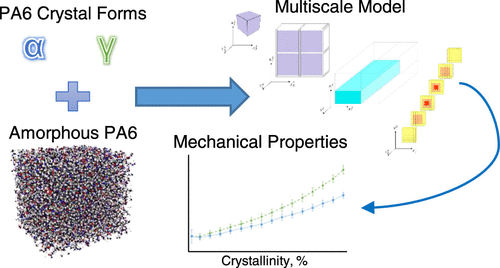当前位置:
X-MOL 学术
›
Ind. Eng. Chem. Res.
›
论文详情
Our official English website, www.x-mol.net, welcomes your feedback! (Note: you will need to create a separate account there.)
Multiscale Modeling of Polyamide 6 Using Molecular Dynamics and Micromechanics
Industrial & Engineering Chemistry Research ( IF 4.2 ) Pub Date : 2021-09-07 , DOI: 10.1021/acs.iecr.1c02440 William A. Pisani 1, 2 , John K. Newman 3 , Manoj K. Shukla 2
Industrial & Engineering Chemistry Research ( IF 4.2 ) Pub Date : 2021-09-07 , DOI: 10.1021/acs.iecr.1c02440 William A. Pisani 1, 2 , John K. Newman 3 , Manoj K. Shukla 2
Affiliation

|
Polyamide 6 (PA6) is a semicrystalline thermoplastic used in many engineering applications due to its high strength, good chemical resistance, and excellent wear/abrasion resistance. The mechanical properties of PA6 are dependent on two forms of crystallinity (α/γ). Semicrystalline thermoplastics have a hierarchical microstructure spanning length scales, necessitating the use of a multiscale model. Molecular dynamics (MD) simulation with the reactive INTERFACE force field was used to predict the elastic moduli of amorphous PA6. Semicrystalline PA6 was modeled using a multiscale modeling approach originally developed for semicrystalline polyetheretherketone (PEEK). This approach was facilitated by the NASA Glenn Research Center’s micromechanics software MAC/GMC. The inputs to the multiscale model were the elastic moduli of amorphous PA6, as predicted via MD and calculated stiffness matrices from the literature of the PA6 α and γ crystal forms. The multiscale model output was Young’s modulus, shear modulus, and Poisson’s ratio as a function of α and γ crystallinity. The predicted values of Young’s modulus and shear modulus compared well with experiment. The multiscale model predictions showed that the mechanical properties of semicrystalline PA6 with α and γ crystal forms are similar from amorphous to 40% crystalline and diverge after this limit, with the γ PA6 predictions having higher Young’s and shear moduli and lower Poisson’s ratio. Overall, the good agreement with experiment validated the use of the multiscale model for semicrystalline PA6, proving that the multiscale model may be used for semicrystalline polymers beyond PEEK.
中文翻译:

使用分子动力学和微力学对聚酰胺 6 进行多尺度建模
聚酰胺 6 (PA6) 是一种半结晶热塑性塑料,由于其高强度、良好的耐化学性和出色的耐磨性,被用于许多工程应用。PA6 的机械性能取决于两种形式的结晶度 (α/γ)。半结晶热塑性塑料具有跨越长度尺度的分层微观结构,因此需要使用多尺度模型。使用反应性界面力场的分子动力学 (MD) 模拟来预测无定形 PA6 的弹性模量。半结晶 PA6 使用最初为半结晶聚醚醚酮 (PEEK) 开发的多尺度建模方法进行建模。美国宇航局格伦研究中心的微机械软件 MAC/GMC 促进了这种方法。多尺度模型的输入是无定形 PA6 的弹性模量,正如通过 MD 预测的,以及从 PA6 α 和 γ 晶型的文献中计算出的刚度矩阵。多尺度模型输出是杨氏模量、剪切模量和泊松比作为 α 和 γ 结晶度的函数。杨氏模量和剪切模量的预测值与实验比较好。多尺度模型预测表明,具有 α 和 γ 晶型的半结晶 PA6 的机械性能从无定形到 40% 结晶相似,并且在此限制后发散,γ PA6 预测具有更高的杨氏模量和剪切模量以及更低的泊松比。总体而言,与实验的良好一致性验证了多尺度模型对半结晶 PA6 的使用,证明多尺度模型可用于 PEEK 以外的半结晶聚合物。
更新日期:2021-09-22
中文翻译:

使用分子动力学和微力学对聚酰胺 6 进行多尺度建模
聚酰胺 6 (PA6) 是一种半结晶热塑性塑料,由于其高强度、良好的耐化学性和出色的耐磨性,被用于许多工程应用。PA6 的机械性能取决于两种形式的结晶度 (α/γ)。半结晶热塑性塑料具有跨越长度尺度的分层微观结构,因此需要使用多尺度模型。使用反应性界面力场的分子动力学 (MD) 模拟来预测无定形 PA6 的弹性模量。半结晶 PA6 使用最初为半结晶聚醚醚酮 (PEEK) 开发的多尺度建模方法进行建模。美国宇航局格伦研究中心的微机械软件 MAC/GMC 促进了这种方法。多尺度模型的输入是无定形 PA6 的弹性模量,正如通过 MD 预测的,以及从 PA6 α 和 γ 晶型的文献中计算出的刚度矩阵。多尺度模型输出是杨氏模量、剪切模量和泊松比作为 α 和 γ 结晶度的函数。杨氏模量和剪切模量的预测值与实验比较好。多尺度模型预测表明,具有 α 和 γ 晶型的半结晶 PA6 的机械性能从无定形到 40% 结晶相似,并且在此限制后发散,γ PA6 预测具有更高的杨氏模量和剪切模量以及更低的泊松比。总体而言,与实验的良好一致性验证了多尺度模型对半结晶 PA6 的使用,证明多尺度模型可用于 PEEK 以外的半结晶聚合物。



























 京公网安备 11010802027423号
京公网安备 11010802027423号